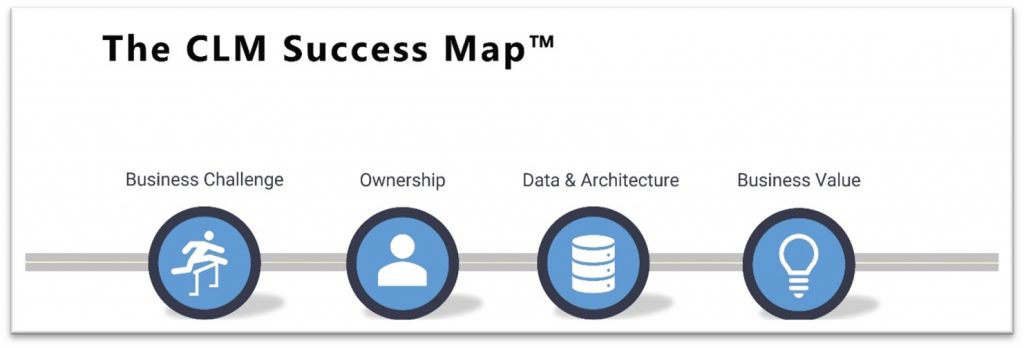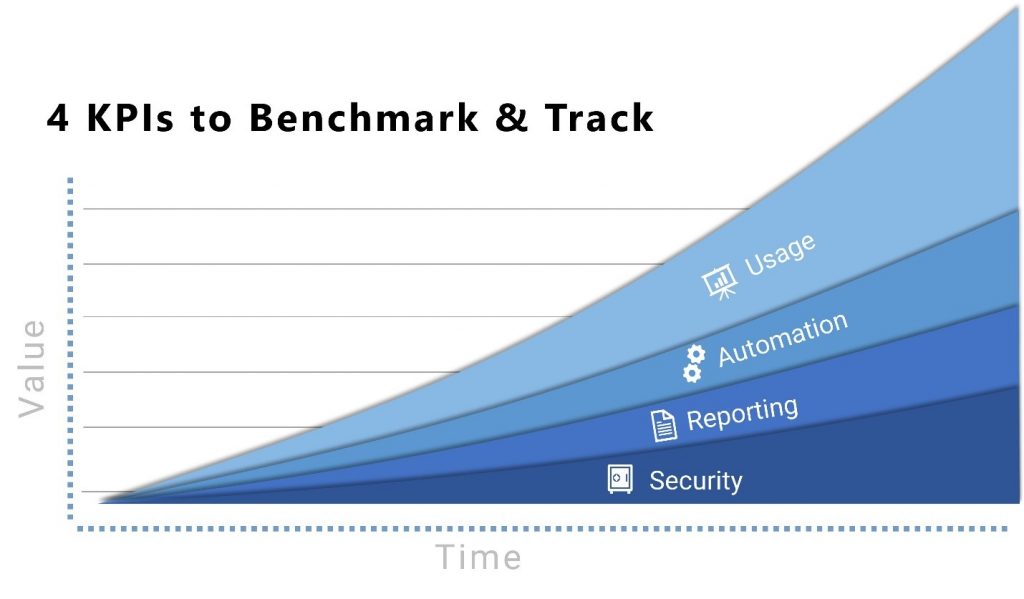The Key to CLM Success is Implementation
Contracting and in-house legal teams continue to face tremendous pressure to digitally transform the way they do business in today’s new operating environment. Most experts agree by now that digital transformation is vital to business success, but legal teams have traditionally been slow to adapt.
The COVID-19 pandemic drastically accelerated many transformation initiatives, and luckily, the rapid adoption of contract lifecycle management (CLM) software has given these organizations the tools and opportunities to be leaders, not laggards, in their company’s broader digital transformation strategies. In fact, according to a recent survey by World Commerce and Contracting, 81% of Legal teams plan to implement, replace, or add to contract automation over the next twelve months. Contract Logix’s own customer usage data has shown an 1800% increase in e-signed contracts, 980% increase in triggered automated workflows, and 830% increase in converted contracts requests from March 2020 to March 2021. Legal’s move to digital transformation has resulted in an explosion of CLM software adoption.
After the decision to purchase, though, how do you measure the success of your actual CLM software implementation? How do you know what key performance indicators (KPIs) to benchmark and track to hold yourself, your organization, and most importantly, your CLM vendor, accountable? After all, selecting the right solution is only half the battle. Just as, if not more, importantly, is getting the software up and running and delivering value to the business.
It All Starts with Implementation
Every successful CLM implementation requires planning ahead and preparation. Granted, you’re going to want to quickly show a fast time to value and return on investment to key stakeholders but it’s important to ask yourself some important questions and take into account some key business considerations before you jump in headfirst.
At Contract Logix, we’ve learned this firsthand. We have over fifteen years of experience helping our customers modernize their contracting processes, but we’ve also had our fair share challenges getting some customers up and running with our CLM software. The good news is we’ve learned from both our successes and our failures implementing software with our customers and we’ve used that knowledge to create a proven model for an effective and timely CLM implementation. We call it the CLM Success Map™ and it includes four core components that ensure a successful CLM implementation every time.

Business Challenge
The Business Challenge phase may seem self-explanatory, but focus is key. What are the use cases for the software? What are your priorities? Are you concentrating on buy-side or sell-side solutions, or vendor management? The most successful CLM implementations are those that take small steps. Think about your user groups and what they need.
Clearly documenting the business problem(s) you need to solve and your organization’s priorities around it is key to success. Are you trying to increase sales velocity or compliance? Are you trying to minimize risk? With the right definition of requirements, you can define which measurements, KPIs and timeframes make the most sense to your organization.
Ownership
Once you’ve clearly defined the business challenge, the next step in the CLM Success Map is determining Ownership. During this phase, you’ll help clarify who is involved in your contracting processes. This requires getting a bit more granular but using a RACI model will help define who’s responsible, who is accountable, as well as what stakeholders need to be consulted or informed about your contracting processes.
You also need to define where your company is on the maturity model. Do you have a solution in place already, or are you starting from scratch? Knowing the answers to these questions will help you create an actionable model where everyone knows what the solution is expected to do. You also need to gain consensus across the various roles — is the solution solving the problem for everyone, or just individual groups?
Data & Architecture
The Data & Architecture phase helps answer questions about how you are managing contract data today as well as your current business processes for CLM and workflows that you want to follow. For example, what contract data exists already and what will you want to incorporate into your system? Do you track contract dates and obligations via spreadsheets? Are all of your contracts electronic or are some paper? In addition, what type of fields are required to be configured in the system such as your contract types, organization types, and contact types.
From a process standpoint, it’s important to understand how a contract needs to be requested, drafted, approved, and executed. What is your process today and does it need to change? All of this influences the configuration of your templates and workflows and your security features as well. Another important thing to consider is whether you’ll have IT resources to support the implementation. If you get your technical resources involved at the outset of an implementation, you are far less likely to run into problems later.
Business Value
Finally, now that you’ve laid the important foundation of understanding the business challenge, ownership, and your data and architecture, what will it take to start realizing business value? Defining what time to value looks like for your business, both from a basic value and exceeded value standpoint, is the only way you will be able to demonstrate success. In addition, time to value ties back to the business challenge or challenges you are trying to solve with your CLM software. You’ll want to set realistic timelines for achieving this, working with everyone defined during the ownership phase. Once you understand your time to value expectations and timeframes, you can now start to think about benchmarking and tracking the KPIs to measure the success of your implementation.
Measuring CLM Implementation Success
Now that you’ve taken the steps necessary to follow the CLM Success Map you can start to measure the success of your implementation using KPIs. And while there are hundreds of individual KPIs you can track, the four main areas you will want to focus on initially include usage, reporting, automation and security. For each of these KPIs, you’ll want to consider your 30-, 60-, and 90-day goals.

Security
CLM software gives you robust security, especially over shared drives, email, spreadsheets, and other manual methods. It is your system of record. In fact, many organizations state lack of security as a top business challenge they are trying to solve with contract management software. Security KPIs should cover your 30-60-90-day goals for setting up roles and feature permissions, organizational hierarchy, users, and other IT considerations. Make it simple and easy, and you’ll make it successful.
Contract Logix employs the latest industry security certifications, practices, technology, and processes to ensure the protection of all our clients’ contract information. Users can establish roles- and feature-based permissions that ensure individuals, and organizations have the appropriate access to contract-related information and capabilities of the software. The platform also provides additional security-first functionality such as SOC 2 Type II compliance, multi-factor authentication (MFA), single single-on (SSO) and data encryption.
Reporting & Analytics
Centralizing all your contracts and data and managing the entire lifecycle in CLM software gives you a single source of truth that you can use to be audit-ready and easily report on in real-time to deliver the business actionable insights.
Reporting and analytics KPIs are all about how you present your data and the information required for reporting contract information to your stakeholders. Define early on what you think you will need to report and analyze for your contracts and contracting processes. Then set your 30-60-90-day goals for getting those data views configured, reports created, and reports shared with the appropriate individuals. Over time and as more data is in your CLM software, you can begin to take advantage of more advanced analytics. It’s important that your CLM software can report in real-time and that creating and sharing reports with other users is simple and intuitive.
Automation
Automation enabled by CLM software gives you speed, efficiency, increased compliance, better user experiences, and more. It helps you streamline your processes. Automation KPIs help you work through making business processes faster, more efficient, and with a better user experience. Look at your current processes and determine which steps take the longest or fall through the cracks, as well as who needs to be alerted about important contract events, assigned tasks, or approve contracts. Where possible, automate these processes early on.
Workflow automation allows you to combine several tasks with one action or click and can automate CLM processes and steps that are tedious or tend to lead to user error such as contract approvals for dollar values over a certain threshold. They can be triggered automatically based on business rules and can guide end users through your process. Most importantly, they ensure everyone is following the same standards. You can also automate contract assembly using clause and template libraries or alerts and notifications of upcoming obligations or renewals. Again, it all depends on the business challenge you need to solve, so set your goals and then closely follow your progress against them.
Usage
Finally, usage is a key measurement of success. The more usage, the better chance you are solving your business problems. For usage KPIs, it’s important to measure usage in several ways including volume and activity across individuals, departments, vendors, requests, and contract types.
For usage, you can set goals around assigned licenses and logins associated with your CLM software. You can also track contract and document volume in the system. The number of contracts getting requested is also an important KPI because this indicates whether users are using the software or operating outside of your desired process. Finally, tracking contracts executed via e-signatures as well as integration with other business applications are also good KPIs around usage.
Takeaway
In-house legal and contracting teams are shifting from laggard to leader when it comes to digital transformation and CLM software is a key enabler. However, purchasing legal technology is only the first step. The real challenge is successfully implementing it in your business in a way that it delivers real value.
Contract Logix has over 15 years of experience working with our customers to implement CLM software and we’ve leveraged that tenure to create the CLM Success Map™. It is a proven recipe for getting organizations up and running fast and effectively to solve their business problems. By leveraging the CLM Success Map and then benchmarking and tracking your implementation KPIs, you can quickly and clearly demonstrate ROI of your contract management software project.
Contact Contract Logix today to learn more about how our CLM software can automate and streamline the entire contract process for your organization while providing data-driven insights to optimize your business.


